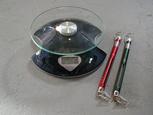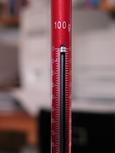Scales
When building small, light models, it is important to use light
materials. A few grams here and there add up to ounces. For example,
when building Tiny, I started comparing the
weight of various components and found that by selecting good
materials and parts, I could avoid about one ounce of weight
difference.
 I use three different scales for weighing models and parts. The first
is the My Weigh 1 Scale 2000 digital kitchen scale from Rollies.com for
under $50. It weighs in units of grams or four-hundreths (.04) of an
ounce (Rollies does not indicate that it will weigh in ounces - it
does.)
I use three different scales for weighing models and parts. The first
is the My Weigh 1 Scale 2000 digital kitchen scale from Rollies.com for
under $50. It weighs in units of grams or four-hundreths (.04) of an
ounce (Rollies does not indicate that it will weigh in ounces - it
does.)
The other two scales are pocket pen-scales, shown to the right of the
kitchen scale in the photo above. One weighs small items up to 10
grams in .1 gram units and the other weighs medium items up to 100
grams in 1 gram units. The 100 gram scale, in the photo to the right,
is the one that I take to the hobby shop to weigh balsa sheets. The
pen scales are under $10 each, also from
Rollies.com.

When I purchase balsa sheets, I write the sheet weight on the label or
in a corner. I then use the sheet from the other end. Going through
my balsa scrap box, I know the weight of each full sheet and whether
it is appropriate for a specific project.
(Rollies also has picures of each scale on their web site.)
Another place that people have found inexpensive, and accurate scales
is www.oldwillknott.com. Others
have reported buying good scales in the $30 range from Ebay.
Back to the home page
Copyright, 2001, Terry Slattery, All rights reserved.
 I use three different scales for weighing models and parts. The first
is the My Weigh 1 Scale 2000 digital kitchen scale from Rollies.com for
under $50. It weighs in units of grams or four-hundreths (.04) of an
ounce (Rollies does not indicate that it will weigh in ounces - it
does.)
I use three different scales for weighing models and parts. The first
is the My Weigh 1 Scale 2000 digital kitchen scale from Rollies.com for
under $50. It weighs in units of grams or four-hundreths (.04) of an
ounce (Rollies does not indicate that it will weigh in ounces - it
does.)
